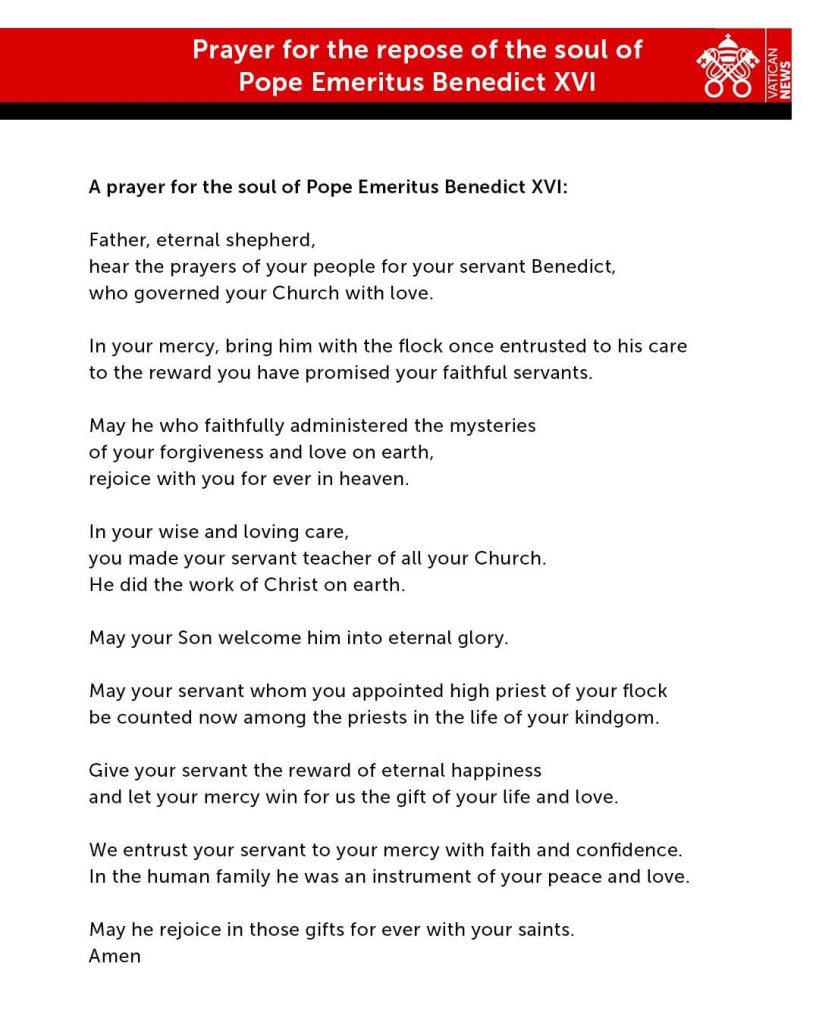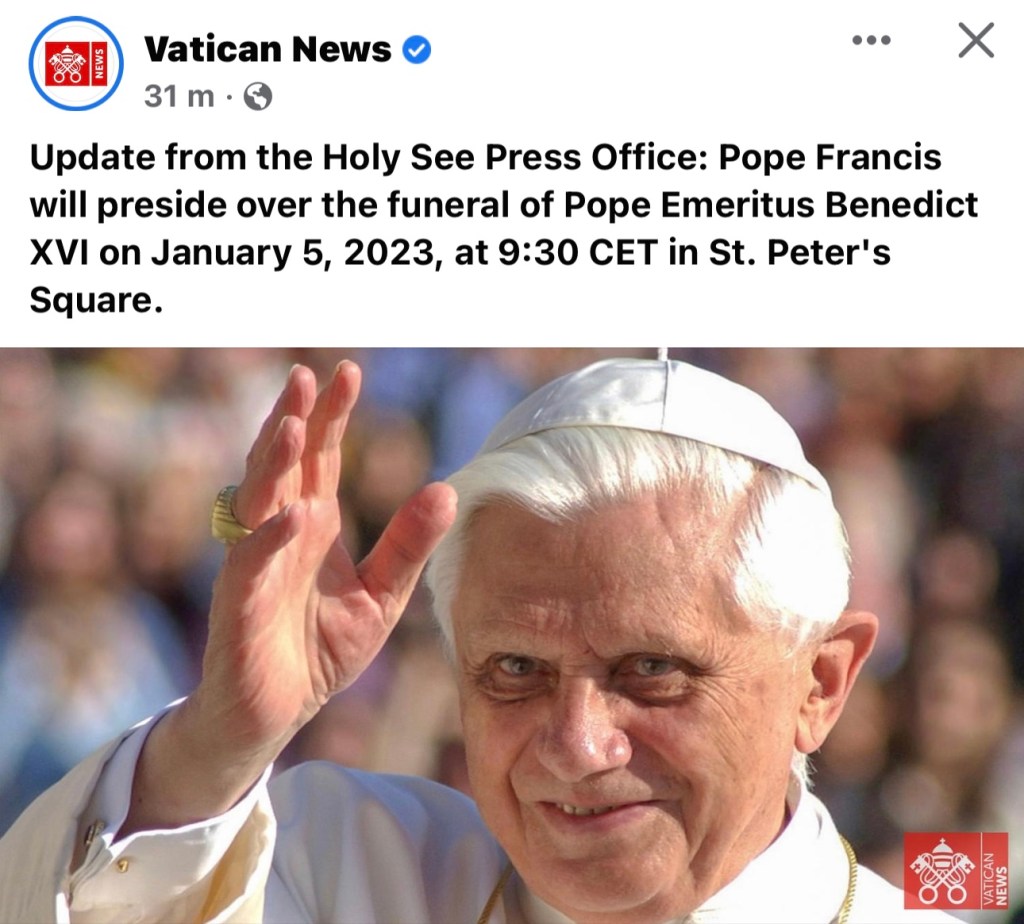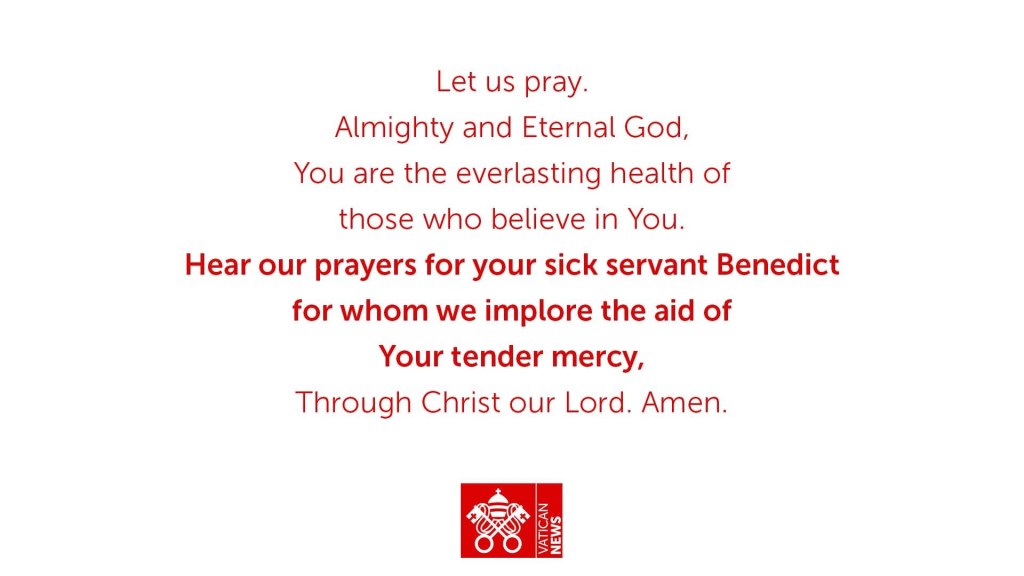His Holiness Pope Francis, the Vicar of Christ and Supreme Pontiff celebrated the Solemn Requiem Mass for His Holiness Pope Benedict XVI assisted by the Dean of the College of Cardinals, His Eminence Cardinal Giovanni Battista Re at St. Peter’s Square in Vatican City, Rome on Thursday, 5 January 2023 at 9.30 am Central European Time (8.30 am UTC)
Pope Benedict XVI
Requiem Mass for His Holiness Pope Benedict XVI from Cathedral of the Good Shepherd, Archdiocese of Singapore
Mass will be livestreamed (and available afterwards) from the link above.
Prayer for the Repose of the Soul of Pope Benedict XVI

Papal Funeral Mass of Pope Benedict XVI will be on 5 January 2023
Pope Francis will preside over the Papal Funeral Mass of Pope Benedict XVI on Thursday, 5 January 2023 at 9.30 am Central European Time (UTC + 1 hour)

Pope Benedict XVI (16 April 1927 – 31 December 2022)

Pope Benedict XVI, 265th Pope, Vicar of Christ and Supreme Pontiff of the One, Holy, Catholic and Apostolic Church has passed away peacefully at 9.34 am Rome time on the last day of the Year of Our Lord 2022, 31 December 2022.
May he rest in peace. Requeiscat in Pace.
Special Request for Prayers for our Pope Emeritus Benedict XVI
A prayer for the health of Pope Emeritus Benedict XVI (from Vatican News)
Let us pray.
Almighty and Eternal God,
You are the everlasting health of
those who believe in You.
Hear our prayers for your sick servant Benedict
for whom we implore the aid of Your tender mercy,
Through Christ our Lord. Amen.

Why did Pope Emeritus Benedict XVI relinquished the Papacy? (My personal opinion)
In my personal opinion, why our beloved Pope Benedict XVI, now Pope Emeritus Benedict XVI, had decided to step down from his position and relinquish the Papacy, is because of three main factors and events that potentially play major roles in shaping his decision. All of these factors are tied to the first factor, that is his health.
Here are the three factors and events that in my opinion made our Pope Emeritus did what he had done :
1. Health : The Pope’s failing health due to his old age is likely the main reason why he had decided to relinquish the Papacy. Although indeed, he is now at 85 being much more vigorous as compared to Blessed Pope John Paul II’s last years, but as the Pope has great tasks to be done, for the sake of the Lord, and His people, Pope Benedict chose humility and step aside for someone else to take over the good works he had started.
He realised that his increasing difficulty in walking, most likely due to osteoarthritis and the problems with his vision will eventually impair him and preventing him from exercising his ministry as the Bishop of Rome. It has also been reported that Pope Benedict too suffers from Parkinson’s, although likely a mild one or one that is still at an early stage. This disease is well known for the one that debilitated Blessed Pope John Paul II, and Pope Benedict, being very close to the previous Pope, would really want to avoid another of many years of debilitation, where the Pope instead of leading directly the Church, had to delegate most of his works due to his disabilities. It is a matter of choice of course. Blessed John Paul II chose to persevere to show us how suffering for the sake of the Lord is like, and our beloved Benedict XVI stepped down to show us what humility and virtue is like.
2. WYD (World Youth Day) 2013 : The World Youth Day has been scheduled to occur in July 2013. It would have been in 2014, but because it will be held in Brazil, which will host the World Cup event in 2014, it was decided to hold the World Youth Day a year earlier. As the Pope’s health has made doctors to advise him strongly against transatlantic and difficult journeys, which would have limited him from visiting any countries outside of Europe, or even Italy in the coming years.
In 2012, his visits had been limited to Mexico, Cuba, and Lebanon, with only two major visits as opposed to the usual four or five visits per year, a clear sign that the Pope’s health is increasingly frail to travel far beyond Rome. As the World Youth Day 2013 will be held in Rio de Janeiro, Brazil, it is also possible that our beloved Benedict XVI chose to step aside that a more capable and vigorous new Pope can go instead to the event, that the new Pope can fully lead the event without the disabilities that increasingly had debilitated our beloved Benedict XVI.
3. Asia, the Church in Asia : Although Pope Benedict XVI had been known as someone who is particularly very attentive to the problems that the Church is facing in Europe and the West in general, which resulted in his numerous visits to the countries mostly in Europe, but he has also made several visits to countries in Latin America and Africa. Many would have criticised him for leaving out Asia, as although Middle Eastern countries like Jordan, Lebanon, Turkey and Israel had been visited rather often in his short pontificate, but he had yet to visit South Asia, Southeast Asia, and East Asia, where the Church, just as in Africa, had been growing very, very rapidly.
The Pope in fact, loved the Church in Asia, particularly the Church in China, which he had tirelessly worked at, in order that the believers in Christ there can be fully reintegrated into the One Body of the Universal Church, free from any form of external and governmental interventions.
Azerbaijan in Central Asia, was the last country in Central Asia visited by a Pope in 2002. But to truly look into Asia, we should go deeper into South Asia, that is India, and further east. The last time a Pope visited India and South Asia was in 1999 or 14 years ago, and the last time a Pope visited Southeast Asia was in 1995 (World Youth Day 1995, Manila, Philippines) or 18 years ago; and for East Asia, the last Papal visit was to Korea in 1989 or 24 years ago.
Several countries in Asia such as Singapore, Indonesia, Korea, Philippines, and some other Asian countries had also been graced with Papal visits only once or twice in the entire history of the Church, also owing to the recent expansion of the Church to Asia and that only beginning with Pope Paul VI, that the Pope began to travel again outside Rome and Italy after quite some time. Therefore, due to Pope Benedict XVI’s love for the Church, both in the elder Europe and the younger Church in Asia, and already that his debilitation had made him difficult to make transatlantic visits, including the upcoming World Youth Day in Brazil, but a travel plan to Asia would have made it much more difficult.
A younger and healthier Pope therefore will be able to visit Asia (South, Southeast, East Asia) perhaps as early as this year or next year, 2014. This is however not to say that an Asian Pope will be elected, just yet. The time has not come yet in this election for an Asian Pope. Only in the next election, which hopefully will be held in about a decade from now or more, that the first Asian Pope may be possibly elected.
In the end, it is Pope Benedict XVI’s love for God, and God’s people in the Church that made him to decide to step aside for the good of the Church and the good of God’s mission in this world. However, this is not at all interpreted that it will be permanently so or that such a stepping down will be customary for the Popes. The Papacy is not an office, and not an institution, which for example like the Archbishop of Canterbury of the Anglicans, which is rotated after every number of years in manner akin to the secular and the worldly prime ministers and presidents. No, the Bishop of Rome’s position, as Christ’s only Vicar on this world is far beyond that. Only the Pope himself can decide when and if he will resign at all, and only in extreme cases should this be done.
Let us all pray therefore for our beloved Pope Emeritus, His Holiness Benedict XVI, that God will continue to look after him in his retirement, that through his new life dedicated in prayer, he can lead the Church with the new Pope, his successor, whom we also pray for, to fight against the evils of this world. We also pray for those who attack the Pope, the institution of our Church, and those who attack the faithful in Christ, that first we forgive them, and ask the Lord to enlighten their hearts, that they will learn the truth about His Church and its teachings, that they too will believe and be saved through the One, Holy, Catholic, and Apostolic Church.
May God bless all of us, bless His One and Universal Church, and bless the whole world. Amen!
How the Conclave proceeds : A very nice and concise animation!
http://vaticaninsider.lastampa.it/en/the-vatican/come-si-elegge-il-papa/
Go and visit this site, which offers a very good and detailed though simple explanations on the way a Conclave proceeds. Not only that it is easy to follow, step-by-step from the beginning of the Conclave to after a new Pope is elected, I believe it’s quite neat too, with all the animations they did for the occasion. Good job Vatican Insider!
Brothers and sisters in Christ, Life goes on : Let’s pray and continue our mission!
Brothers and sisters in Christ, life is still ongoing. Even if we are saddened by the resignation of our Holy Father, Pope Benedict XVI, let us show him our support by continuing to do our mission in the Church, for the good of all.
Now that we are waiting for the new Pope to be elected, let us fervently pray that God will give us a great new shepherd to succeed our beloved Pope, Benedict XVI. May God bless all of us. Amen!
As I am currently studying Italian and Latin, I am also writing this in Italian too (below) for my revision. If there is any mistake, do notify me and correct me.
Fratelli e sorelle in Cristo, la vita è ancora in corso. Anche se siamo addolorati per le dimissioni del nostro Santo Padre, Papa Benedetto XVI, cerchiamo di fargli vedere il nostro sostegno continuando a fare la nostra missione nella Chiesa, per il bene di tutti.
Ora che siamo in attesa per il nuovo papa ad essere eletto, con fervore pregare che Dio ci darà un grande nuovo pastore per avere successo il nostro amato Papa, Benedetto XVI. Che Dio benedica tutti noi. Amen!
